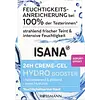What's inside
What's inside
 Key Ingredients
Key Ingredients

 Benefits
Benefits

 Concerns
Concerns

 Ingredients Side-by-side
Ingredients Side-by-side

Water
Skin ConditioningGlycerin
HumectantPanthenol
Skin ConditioningPropylene Glycol
HumectantNiacinamide
SmoothingBetaine
HumectantButylene Glycol
HumectantEnantia Chlorantha Bark Extract
Skin ConditioningOleanolic Acid
Skin ConditioningInulin
Skin ConditioningAlpha-Glucan Oligosaccharide
CleansingDimethicone/Vinyl Dimethicone Crosspolymer
Skin ConditioningSilica
AbrasivePEG-40 Hydrogenated Castor Oil
EmulsifyingArctium Lappa Root Extract
Skin ConditioningNasturtium Officinale Leaf Extract
MaskingSalvia Officinalis Leaf Extract
CleansingPhenoxyethanol
PreservativeAcrylates/C10-30 Alkyl Acrylate Crosspolymer
Emulsion StabilisingTriethanolamine
BufferingDisodium EDTA
Water, Glycerin, Panthenol, Propylene Glycol, Niacinamide, Betaine, Butylene Glycol, Enantia Chlorantha Bark Extract, Oleanolic Acid, Inulin, Alpha-Glucan Oligosaccharide, Dimethicone/Vinyl Dimethicone Crosspolymer, Silica, PEG-40 Hydrogenated Castor Oil, Arctium Lappa Root Extract, Nasturtium Officinale Leaf Extract, Salvia Officinalis Leaf Extract, Phenoxyethanol, Acrylates/C10-30 Alkyl Acrylate Crosspolymer, Triethanolamine, Disodium EDTA
Water
Skin ConditioningAloe Barbadensis Leaf Juice
Skin ConditioningCoco-Caprylate/Caprate
EmollientGlycerin
HumectantCetearyl Alcohol
EmollientHelianthus Annuus Seed Oil
EmollientBetaine
HumectantPotassium Cetyl Phosphate
EmulsifyingOctyldodecanol
EmollientHydrogenated Palm Glycerides
EmollientBeta Vulgaris Root Extract
Skin ConditioningFructooligosaccharides
HumectantCellulose
AbsorbentMacadamia Integrifolia Seed Oil
Skin ConditioningSodium Hyaluronate
HumectantPanthenol
Skin ConditioningButyrospermum Parkii Butter
Skin ConditioningTocopherol
AntioxidantPhenoxyethanol
PreservativeParfum
MaskingPotassium Lactate
BufferingEthylhexylglycerin
Skin ConditioningXanthan Gum
EmulsifyingLactic Acid
BufferingAlcohol
AntimicrobialSodium Hydroxide
BufferingTris(Tetramethylhydroxypiperidinol)Citrate
StabilisingPantolactone
HumectantCitric Acid
BufferingAnise Alcohol
PerfumingCI 42090
Cosmetic ColorantWater, Aloe Barbadensis Leaf Juice, Coco-Caprylate/Caprate, Glycerin, Cetearyl Alcohol, Helianthus Annuus Seed Oil, Betaine, Potassium Cetyl Phosphate, Octyldodecanol, Hydrogenated Palm Glycerides, Beta Vulgaris Root Extract, Fructooligosaccharides, Cellulose, Macadamia Integrifolia Seed Oil, Sodium Hyaluronate, Panthenol, Butyrospermum Parkii Butter, Tocopherol, Phenoxyethanol, Parfum, Potassium Lactate, Ethylhexylglycerin, Xanthan Gum, Lactic Acid, Alcohol, Sodium Hydroxide, Tris(Tetramethylhydroxypiperidinol)Citrate, Pantolactone, Citric Acid, Anise Alcohol, CI 42090
 Reviews
Reviews

Ingredients Explained
These ingredients are found in both products.
Ingredients higher up in an ingredient list are typically present in a larger amount.
Betaine is a common humectant (a substance that promotes retention of moisture). It's known to be gentle on the skin and can help balance hydration.
This ingredient is best for improving hydration and soothing irritated skin. Studies also show it helps even out skin tone.
Fun fact: Betaine is naturally created in the skin and body. The kind found within cosmetic products can be either plant-derived or synthetic.
Another name for betaine is trimethylglycine.
Learn more about BetaineGlycerin is already naturally found in your skin. It helps moisturize and protect your skin.
A study from 2016 found glycerin to be more effective as a humectant than AHAs and hyaluronic acid.
As a humectant, it helps the skin stay hydrated by pulling moisture to your skin. The low molecular weight of glycerin allows it to pull moisture into the deeper layers of your skin.
Hydrated skin improves your skin barrier; Your skin barrier helps protect against irritants and bacteria.
Glycerin has also been found to have antimicrobial and antiviral properties. Due to these properties, glycerin is often used in wound and burn treatments.
In cosmetics, glycerin is usually derived from plants such as soybean or palm. However, it can also be sourced from animals, such as tallow or animal fat.
This ingredient is organic, colorless, odorless, and non-toxic.
Glycerin is the name for this ingredient in American English. British English uses Glycerol/Glycerine.
Learn more about GlycerinPanthenol is a common ingredient that helps hydrate and soothe the skin. It is found naturally in our skin and hair.
There are two forms of panthenol: D and L.
D-panthenol is also known as dexpanthenol. Most cosmetics use dexpanthenol or a mixture of D and L-panthenol.
Panthenol is famous due to its ability to go deeper into the skin's layers. Using this ingredient has numerous pros (and no cons):
Like hyaluronic acid, panthenol is a humectant. Humectants are able to bind and hold large amounts of water to keep skin hydrated.
This ingredient works well for wound healing. It works by increasing tissue in the wound and helps close open wounds.
Once oxidized, panthenol converts to pantothenic acid. Panthothenic acid is found in all living cells.
This ingredient is also referred to as pro-vitamin B5.
Learn more about PanthenolPhenoxyethanol is a preservative that has germicide, antimicrobial, and aromatic properties. Studies show that phenoxyethanol can prevent microbial growth. By itself, it has a scent that is similar to that of a rose.
It's often used in formulations along with Caprylyl Glycol to preserve the shelf life of products.
Water. It's the most common cosmetic ingredient of all. You'll usually see it at the top of ingredient lists, meaning that it makes up the largest part of the product.
So why is it so popular? Water most often acts as a solvent - this means that it helps dissolve other ingredients into the formulation.
You'll also recognize water as that liquid we all need to stay alive. If you see this, drink a glass of water. Stay hydrated!
Learn more about Water